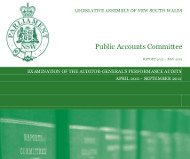6/11/2013
Australia: Report Finds Need For Speed Camera TransparencyNew South Wales, Australia parliamentary committee finds state government misleads on speed-related accident data.

Speed camera data is being kept too hidden, according to a report released last month by the the New South Wales, Australia Legislative Assembly. The findings came as the Public Accounts Committee reviewed a number of 2011 performance audits, including the examination of speed cameras (view 2011 audit), to verify whether the auditor's recommendations have been implemented.
In NSW, the state Road and Traffic Authority (RTA) contracts with Redflex Traffic Systems to run the fixed and mobile speed cameras that generate 370,000 tickets a year worth $58 million in net profit. The auditor general asked the public to provide an opinion on the use of automated ticketing, and 69 percent agreed the cameras were only meant to be "revenue-raisers." Only 15 percent supported their use. The widespread skepticism is bolstered by belief that the cameras are not positioned in locations known to be the most dangerous.
"The Auditor-General found that there was no overall criteria to determine the most appropriate camera type for roads classed as high risk," the committee report explained. "The audit found that camera type dictates site selection decisions, rather than the nature of the black spots."
The committee follow-up determined officials at RTA responded to the audit by creating a public relations campaign meant to convince motorists of the benefits of speed cameras.
"This strategy aims to outline the current speeding problem, community attitudes to speeding and speed enforcement and clearly articulate the benefits of a comprehensive speed camera strategy for speed cameras in NSW," the RTA response stated. "The strategy reassures the community that speed enforcement together with comprehensive public education campaigns and engineering treatments can save lives on our roads."
In April, Roads Minister Duncan Gay moved two speed cameras that had been placed in an inappropriate location. Transport for NSW officials also confirmed that the camera manufacturer had tested all of its cameras and self-certified their accuracy. The state agency denied it needed independent certification from Australia's National Measurement Institute (NMI) to properly measure speed and it stood by the statistical techniques used to justify photo enforcement.
"NSW figures currently state that 42 per cent of all fatal crashes are caused by speed," the committee report stated. "This is used as a key rationale for the use and placement of speed cameras in NSW."
This figure is generated by listing as speed-related any collision that involves driving too fast for the conditions, even when that speed is below the posted speed limit. It also includes drunk drivers, thieves attempting to outrun police and other cases where speed is one of many contributing factors.
"The committee believes that TfNSW should be more specific in its reporting on the statistics regarding fatal crashes," the parliamentary report explained. "If speed is not the only reason for the crash then this should be captured. For example, if a drunk driver has a crash involving speed then both speed and alcohol should be reported as a cause of the crash. The committee is concerned that incidents where speed is involved, but is not the main cause, are not reflected adequately in the statistics reported by TfNSW."
A copy of the parliamentary report is available in a 1mb PDF file in the source link below.


